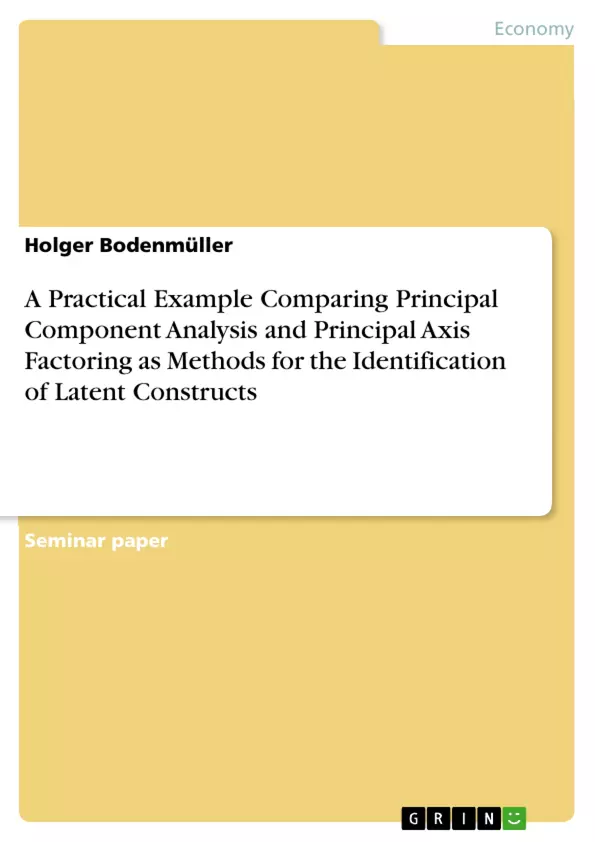In this paper the historical and theoretical background of the factor analysis is briefly explained. Principal Component Analysis (PCA) and Principal Axis Factoring (PAF) are applied to a data set which has been generated in the scope of the evaluation of the implementation of Company X’s corporate Strategy XX. The results clearly indicate that structural parts of the data collection instrument could be reproduced by the empirical data.
The primary factors resulting from an orthogonal respectively oblique rotation are comparable but also show slight differences. Latent constructs like “Trust”, “Job Satisfaction” “Disengagement” and “Pessimism” are indicated by the results. Secondary factors indicate a negative relationship between disengagement and leadership respectively transparency concerning the corporate strategy and job satisfaction. Also aspects of “state negativity” can be identified. This means that a general pessimistic attitude is related to a more pessimistic view on realized customer focus. The application of more elaborated methods would be needed to identify causal relationships.
Inhaltsverzeichnis (Table of Contents)
- Executive Summary
- Table of Contents
- List of Abbreviations
- List of Figures
- List of Tables
- Introduction/Problem Definition
- Objectives
- Methodology
- Factor Analysis: Historical and Theoretical Basics
- Factor Analysis: Parameters
- Factor Score
- Factor/Factor Loading
- Communality (h²)
- Eigenvalue
- Rotation
- PCA
- PAF and Oblique Rotation
- Data Sample and Analysis
- Construct Structure of the Questionnaire
- Sample Structure and Survey Conduction
- Hypothesis/Questions
- Data Analysis
- Results PCA
- Results PAF
- Secondary Factors
- Conclusion
- Appendix
- ITM Checklist
- Bibliography
Zielsetzung und Themenschwerpunkte (Objectives and Key Themes)
This paper aims to provide a comprehensive understanding of factor analysis, including its historical and theoretical underpinnings. It specifically examines the application of Principal Component Analysis (PCA) and Principal Axis Factoring (PAF) to a real-world data set, focusing on the evaluation of Company X's corporate strategy "XX".
- Historical and theoretical background of factor analysis
- Parameters of factor analysis, including factor scores, loadings, communalities, eigenvalues, and rotation
- Specific characteristics of PCA and PAF as methods for identifying latent constructs
- Application of PCA and PAF to a complex data set, analyzing the results of a corporate strategy evaluation
- Identification and interpretation of latent constructs and relationships within the data
Zusammenfassung der Kapitel (Chapter Summaries)
The paper begins by introducing the concept of factor analysis and its application in data reduction. It highlights the importance of carefully selecting the method and parameters to ensure empirical validity. The following chapters delve into the historical and theoretical foundations of factor analysis, defining key parameters like factor scores, loadings, and eigenvalues. The paper then examines the unique characteristics of PCA and PAF as approaches to factor analysis, illustrating their application through the analysis of a data set collected from an internal survey evaluating Company X's corporate strategy "XX". The analysis explores the construct structure of the questionnaire, sample structure, hypothesis, and data analysis methods used. Finally, the results of both PCA and PAF are presented, including the identification of latent constructs and secondary factors.
Schlüsselwörter (Keywords)
Factor analysis, Principal Component Analysis (PCA), Principal Axis Factoring (PAF), latent constructs, data reduction, corporate strategy evaluation, data analysis, SPSS, rotation, eigenvalues, loadings, communalities, secondary factors.
- Quote paper
- Holger Bodenmüller (Author), 2011, A Practical Example Comparing Principal Component Analysis and Principal Axis Factoring as Methods for the Identification of Latent Constructs, Munich, GRIN Verlag, https://www.grin.com/document/294583




